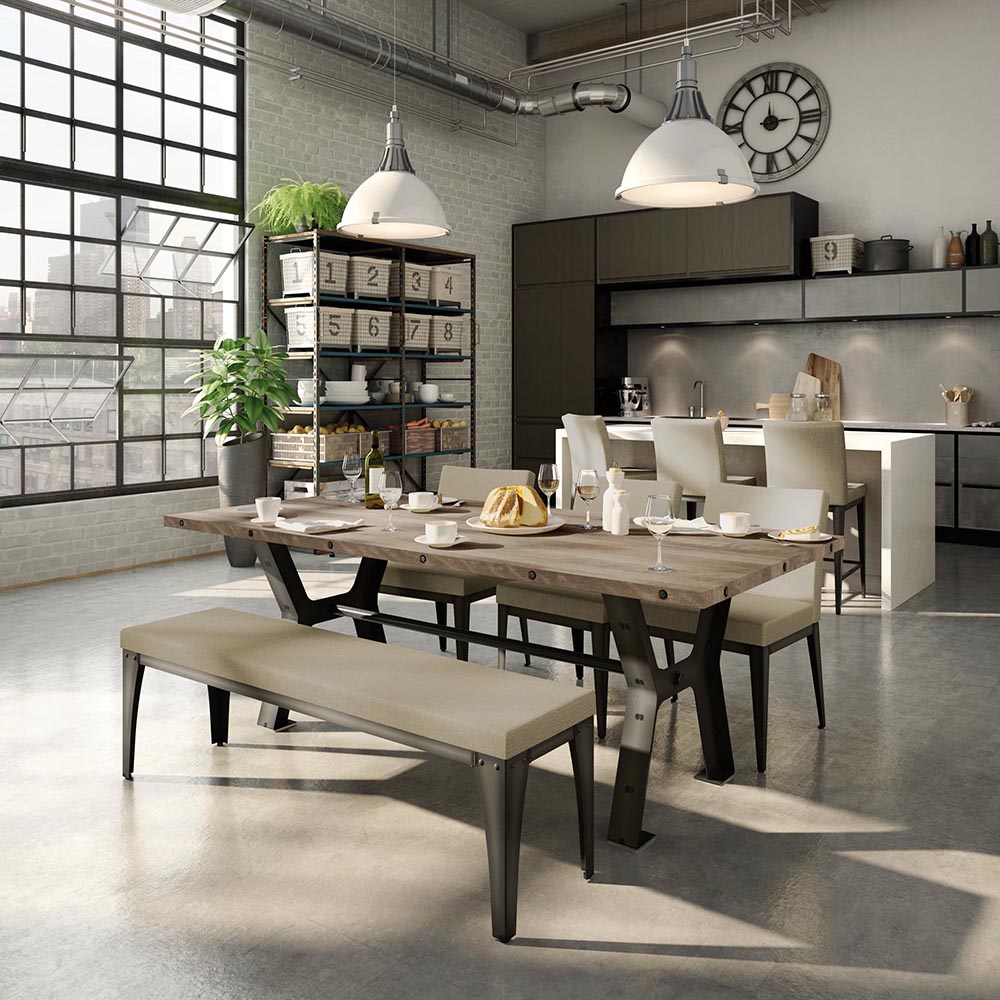The kitchen table, a seemingly simple piece of furniture, has been at the heart of human dwellings for millennia. Its evolution mirrors the changes in our society, technology, and daily lives. From ancient stone slabs to sleek, modern designs, the kitchen table has adapted to our needs while remaining a central gathering point in our homes. In this post, we’ll explore the fascinating journey of the kitchen table through history and examine its myriad uses in contemporary life.
The Early Days: From Stone to Wood
Our story begins in prehistoric times when early humans gathered around fires to share meals. The ground or large, flat stones served as the first “tables.” As civilizations developed, so did the concept of a dedicated eating surface. Ancient Egyptians used small tables and stools, while Greeks and Romans reclined on couches around low tables during their feasts.
The medieval period saw the emergence of the trestle table in European homes. These long, narrow tables could be easily dismantled and stored when not in use, making them ideal for the multipurpose great halls of the time. They were typically made of wood, a material that would dominate table construction for centuries to come.
The Renaissance and the Birth of the Modern Kitchen Table
The Renaissance brought about significant changes in home design and furniture. As houses began to include separate rooms for specific functions, the kitchen emerged as a distinct space. This period saw the development of the kitchen table as we might recognize it today – a sturdy, permanent fixture designed for food preparation and family meals.
In rural homes, the kitchen table often doubled as a workspace for various household tasks. It was common to see large, rectangular tables made of sturdy woods like oak or pine, built to withstand years of heavy use.
Industrial Revolution: Mass Production and New Materials
The Industrial Revolution of the 18th and 19th centuries had a profound impact on furniture production, including kitchen tables. Mass manufacturing techniques made tables more affordable and accessible to a broader range of people. New materials like cast iron allowed for the creation of more diverse designs.
This era also saw the popularization of the kitchen table and chairs set. As urban populations grew and living spaces became smaller, the idea of a dedicated dining room became less common for working-class families. The kitchen table took on the role of the main eating area in many homes.
20th Century: Formica and the Rise of Modern Design
The early 20th century brought about another revolution in kitchen table design with the invention of Formica in 1912. This durable, easy-to-clean laminate became incredibly popular for kitchen surfaces, including tables. The 1950s saw an explosion of colorful, chrome-trimmed Formica tables that have become iconic of mid-century design.
Modernist designers also began experimenting with new shapes and materials. Eero Saarinen’s pedestal table, introduced in 1957, showcased a sleek, space-age aesthetic that influenced kitchen table design for decades to come.
The latter half of the 20th century saw a diversification of styles to suit various tastes and home designs. From rustic farmhouse tables to minimalist Scandinavian designs, the kitchen table adapted to changing aesthetic preferences while maintaining its central role in family life.
Contemporary Uses: More Than Just a Dining Surface

Today, the kitchen table serves a multitude of purposes beyond its traditional role as a dining surface. Let’s explore some of the ways modern families use their kitchen tables:
- Home Office: With the rise of remote work, many people have turned their kitchen tables into temporary or permanent home offices. The ample surface area provides space for laptops, documents, and other work essentials.
- Homework Station: For families with school-age children, the kitchen table often becomes a homework hub. Its central location allows parents to supervise and assist while preparing meals or managing other household tasks.
- Craft and Hobby Area: From scrapbooking to model building, the kitchen table provides an ideal surface for various hobbies and crafts. Its durability and easy-to-clean nature make it perfect for messy projects.
- Game Night Central: Family game nights often center around the kitchen table. Its size accommodates board games, card games, and puzzles, fostering bonding and entertainment.
- Baking and Food Prep: Beyond regular meal prep, kitchen tables are often used for more elaborate cooking projects. Rolling out pie crusts, decorating cakes, or assembling large batches of food are all made easier with the extra space a kitchen table provides.
- Social Hub: The kitchen table remains a primary gathering spot for friends and family. Whether it’s for coffee, snacks, or full meals, it continues to be a place for conversation and connection.
- Planning Center: Many families use their kitchen table as a command center for organizing schedules, paying bills, and planning events. Its central location makes it an ideal spot for family meetings and discussions.
- Display Area: In open-concept homes, the kitchen table often serves as a display surface for decorative items, helping to bridge the gap between kitchen and living areas.
Modern Design Trends

As our uses for the kitchen table have evolved, so too have design trends. The contemporary kitchen table serves as more than just a dining surface; it’s often a multifunctional centerpiece of the home. Here are some current popular styles and features that people are seeking in kitchen tables:
- Multifunctional Tables: Tables with built-in storage, expandable surfaces, or convertible features are gaining popularity, especially in smaller homes. People are looking for tables that can adapt to different needs, such as leaves that extend to accommodate guests or drawers for storing placemats and cutlery.
- Sustainable Materials: There’s a growing interest in tables made from reclaimed wood, bamboo, and other eco-friendly materials. Consumers are increasingly environmentally conscious and want furniture that reflects these values.
- Mixed Materials: Combinations of wood, metal, glass, and stone create interesting visual textures and suit a variety of decor styles. For example, a wooden top with metal legs or a glass surface with a stone base.
- Smart Tables: Some high-tech kitchen tables now incorporate charging stations, touchscreen surfaces, or even cooking elements. These appeal to tech-savvy homeowners who want to integrate technology seamlessly into their living spaces.
- Adjustable Height: Tables that can switch between standard and counter height offer versatility for different uses throughout the day, from casual dining to work surface to bar-height entertaining.
- Space-Saving Designs: With many people living in smaller spaces, there’s a demand for tables that can be easily stored or take up minimal space. This includes wall-mounted drop-leaf tables, nesting tables, or tables with folding components.
- Organic Shapes: Moving away from traditional rectangular designs, many consumers are drawn to tables with rounded edges, oval shapes, or irregular organic forms that add visual interest and can make a space feel more open.
- Bold Colors: While natural wood tones remain popular, there’s also a trend towards tables in bold, statement colors that can serve as a focal point in the kitchen.
- Textured Surfaces: Tables with interesting textures, such as live-edge wood, hammered metal, or tactile finishes, are appealing to those who want to add depth and character to their space.
- Customizable Options: Many consumers are looking for tables that can be customized to their specific needs and aesthetic preferences, whether through choice of materials, sizes, or modular components.
- Indoor-Outdoor Versatility: With the increasing popularity of outdoor living spaces, there’s a growing demand for tables that can transition seamlessly between indoor and outdoor use.
- Minimalist Designs: Clean lines and simple forms continue to be popular, appealing to those who prefer a sleek, uncluttered look in their kitchen.
Find the Perfect Kitchen Table to Meet Your Family’s Needs

These trends reflect a broader shift towards kitchen tables that are not only functional but also adaptable, sustainable, and expressive of personal style. As the kitchen continues to be the heart of the home, the table within it is expected to meet a diverse range of needs and aesthetic preferences.
The kitchen table has come a long way from its humble beginnings as a simple eating surface. Through centuries of cultural shifts, technological advancements, and changing lifestyles, it has remained a constant presence in our homes. Today’s kitchen table is a multifunctional piece of furniture that adapts to our diverse needs while continuing to serve its most important role – bringing people together.
You’ll find the perfect kitchen table to meet all your family’s needs at California Dining & Barstools. Browse our wide selection of high-quality dining sets and dinettes at our two showrooms in the Bay Area.
